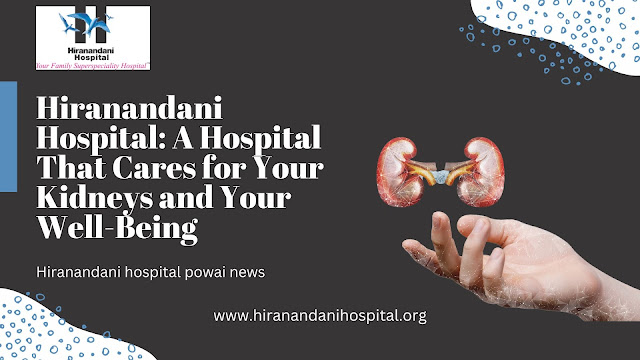Inside Polycystic Kidney Disease: A Guide to Understanding the Inherited Condition
Polycystic Kidney Disease (PKD) is a genetic condition that affects millions of people worldwide. It is a chronic and progressive disorder that causes fluid-filled cysts to develop in the kidneys, leading to their enlargement and eventual failure. PKD can also cause cysts to develop in other organs, such as the liver and pancreas.
This inherited condition can be challenging
to manage, but with the right information, support, and treatment, it is
possible to live a fulfilling life with PKD, says the Kidney Expert at the
Hiranandani Hospital Kidney.
The genetic basis of PKD
PKD is caused by mutations in the PKD1 or
PKD2 genes, which are responsible for producing proteins that regulate the
growth and development of kidney cells. These mutations cause the cells to grow
and divide abnormally, leading to the formation of cysts. PKD is an autosomal
dominant genetic disorder, which means that only one copy of the mutated gene
is needed to develop the disease. If one parent has PKD, there is a 50% chance
that their child will inherit the condition.
Although PKD is an inherited condition, it
can also occur spontaneously due to a new mutation in the genes. In these
cases, there may be no family history of the disease, as observed in a handful
of cases at the Hiranandani
Hospital Kidney Transplant. PKD affects both men and women equally and can
occur at any age, although it is most commonly diagnosed in adults between the
ages of 30 and 50.
Types of PKD
There are two main types of PKD: Autosomal
Dominant PKD (ADPKD) and Autosomal Recessive PKD (ARPKD). ADPKD is the most
common type of PKD, accounting for 90% of cases. It usually develops in
adulthood, although symptoms may not appear until later in life. ARPKD is a
rare and more severe form of disease that usually presents in infancy or
childhood. It can lead to kidney failure in early childhood or adolescence.
Symptoms and diagnosis of PKD
The symptoms of PKD can vary depending on
the type of PKD and the stage of the disease. In the early stages, there may be
no symptoms, and the condition may only be detected through imaging tests. As
the cysts grow larger and multiply, they can cause several symptoms, including:
• Abdomen
back pain
• High
blood pressure
• Blood
in the urine
• Frequent
urination
• Urinary
tract infections
• Kidney
stones
• Fatigue
• Loss
of appetite
• Headaches
If you experience any of these symptoms, it
is essential to consult a healthcare professional. A diagnosis of PKD is
usually made through imaging tests such as ultrasound, CT scan, or MRI. Genetic
testing can also be used to confirm the diagnosis and identify the specific gene
mutation responsible for the condition.
Treatment options for PKD
There is currently no cure for PKD, but
several treatment options can help manage the symptoms and slow down the
progression of the disease. Treatment options may include:
• Medications
to control blood pressure and reduce the risk of kidney damage
• Diuretics
to vacate surplus fluid from the body
• Antibiotics
to treat urinary tract infections
• Pain
medication to manage discomfort
• Surgery
to drain cysts or remove a kidney in severe cases
• Dialysis
or kidney transplant in end-stage kidney disease
A healthcare professional will create a
treatment plan based on the specific needs and stage of the disease. It is
essential to follow the treatment plan and attend regular check-ups to monitor
the progression of the disease.
Lifestyle modifications for PKD patients
In addition to medical treatment, lifestyle
modifications can also help manage the symptoms of PKD and improve overall
health, say doctors at the HiranandaniHospital Kidney. These modifications may include:
• Maintaining
a healthy diet low in sodium and protein to reduce the workload on the kidneys
• Regular
exercise to maintain a healthy weight and improve cardiovascular health
• Quitting
smoking and limiting alcohol consumption to reduce the risk of kidney damage
• Management
of stress through leisure methods such as meditation or yoga
• Getting
sufficient rest and sleep to permit the body to recover and revitalize
Support groups for PKD patients and
their families
Living with PKD can be challenging, and it
is essential to have a strong support system in place. Several support groups
and organizations provide resources, information, and emotional support to
individuals with PKD and their families. These groups can help connect
individuals with others who are going through similar experiences and provide a
safe space to share their stories and feelings.
Research advancements in PKD
Research into PKD is ongoing, and several
advancements have been made in recent years. These advancements include the
development of new medications and therapies aimed at slowing down the
progression of the disease and improving the quality of life of individuals
with PKD. There is also ongoing research into the genetic basis of the disease,
which may lead to new treatments and a better understanding of the condition.
Coping with PKD: Personal stories
Living with PKD can be challenging, but
many individuals have learned to manage the condition and live fulfilling
lives. Personal stories and experiences can provide valuable insights and
inspiration to those living with PKD. These stories can help individuals
understand that they are not alone and that there is hope for a bright future.
Conclusion
PKD is a complex and inherited condition
that affects millions of people worldwide. Although there is currently no cure
for PKD, several treatments and lifestyle modifications can help manage the
symptoms and slow down the progression of the disease. It is essential to
consult a healthcare professional if you experience any symptoms of PKD and to
follow the recommended treatment plan. Support groups and organizations can
also provide valuable resources and emotional support to individuals with PKD
and their families. With the right information, support, and treatment, it is
possible to live a fulfilling life with PKD.


Comments
Post a Comment